February 2/15
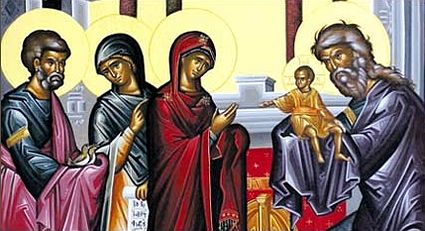 Icon of The Presentation of Christ written by the hand of Athanasios Clark and used with permission. © Greek Orthodox Archdiocese of America
Icon of The Presentation of Christ written by the hand of Athanasios Clark and used with permission. © Greek Orthodox Archdiocese of America
INTRODUCTION
This feast, celebrated on February 2, is known in the Orthodox Church as The Presentation of Christ in the Temple. Another name for the feast is The Meeting of our Lord. Roman Catholic and Protestant Christians call the feast, The Purification of the Holy Virgin. About 450 AD in Jerusalem, people began the custom of holding lighted candles during the Divine Liturgy of this feast day. Therefore, some churches in the West refer to this holy day as Candlemas. The Feast of the Presentation concludes the observances related to the Nativity of Christ, a period that opened on November 15 with the beginning of the Nativity fast.
BIBLICAL STORY
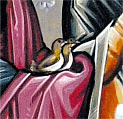 Joseph and Mary were not wealthy, so they took two turtle doves with them to offer as a sacrifice at the Temple.
Joseph and Mary were not wealthy, so they took two turtle doves with them to offer as a sacrifice at the Temple.
When Jesus was forty days old, Mary and Joseph took Him to the Temple in Jerusalem. They were not wealthy, so they took two turtle doves with them to offer as a sacrifice at the Temple. As they arrived at the Temple, Mary and Joseph were met by a very old man named Simeon. He was a holy man and was noted as a very intelligent scholar. Simeon spent much time studying about the prophets of Israel. It was during his studies that he learned of the coming of the Messiah. The Jewish people were waiting for the Messiah to come and deliver Israel from their conquerors. From that time on, Simeon spent his time praying for the Messiah to come. He spent many years in prayer. Finally, while Simeon was praying he heard the voice of God. God promised Simeon that he would not die until he had seen the Messiah.
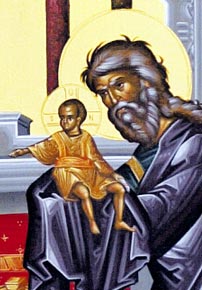 Simeon took Jesus in his arms and praised God.
Simeon took Jesus in his arms and praised God.
"Lord, now let Your servant go in peace according to Your promise, because my eyes have seen Your salvation which you have prepared before the face of all peoples, a light to bring revelation to the Gentiles, and the glory to your people Israel."
Also, in the Temple was Anna the Prophetess. She had been a widow for many years. Anna was about eighty-four years old and spent her time in the Temple worshiping, fasting, and praying. When she saw the Christ Child she praised God and spoke of him to all who were awaiting the Messiah.
After Jesus was presented in the Temple, the family returned to Galilee to the town of Nazareth. The Bible tells us that Jesus grew and became strong, and was filled with wisdom.
ICON OF THE FEAST
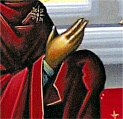 The Theotokos is holding out her hands in a gesture of offering and humility.
The Theotokos is holding out her hands in a gesture of offering and humility.
Christ is shown as a child, but He is not in swaddling clothes. He is clothed in a small dress and his legs are bare. Jesus appears to be giving a blessing. Simeon holds Jesus with both hands which are covered. This shows the reverence Simeon had for the Messiah. Simeon is bare headed and there is nothing to show that he is a priest. Some biblical scholars say that Simeon was probably a priest of the Temple or a Doctor of the Law.
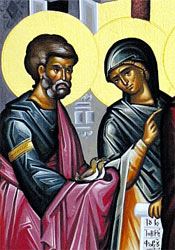 Joseph offers the sacrifice of a poor family while Anna the Prophetess praises God and "speaks about the child to all who were looking for the redemption of Jerusalem." Luke 2: 38
Joseph offers the sacrifice of a poor family while Anna the Prophetess praises God and "speaks about the child to all who were looking for the redemption of Jerusalem." Luke 2: 38
The words Simeon spoke when he saw the Christ Child are known as "St. Simeon's Prayer." This prayer is sung daily at the evening Vespers services of the Orthodox Church.
In the Orthodox Church, both baby boys and baby girls are taken to the Church on the fortieth day after their birth. This is done in remembrance of the Theotokos and Joseph taking the infant Jesus to the Temple.
ORTHODOX CELEBRATION OF THE FEAST OF THE PRESENTATION
This Feast of our Lord is celebrated with the Divine Liturgy of Saint John Chrysostom, which is conducted on the day of the Feast and preceded by the Matins service. A Great Vespers is conducted on the evening before the day of the Feast. Scripture readings for the Feast are the following: at Great Vespers – extracts from Exodus 12:15-13:16; Leviticus 12 and Numbers 8; Isaiah 6:1-12, and 19:1,3-5,12,16,19-21; at Matins – Luke 2:25-32; at the Divine Liturgy – Hebrews 7:7-17 and Luke 2:22-40.
HYMNS OF THE FEAST
Apolytikion (First Tone)
Hail Virgin Theotokos full of Grace, for Christ our God, the Sun of Righteousness, has dawned from you, granting light to those in darkness. And you, O Righteous Elder, rejoice, taking in Your arms, the Deliverance of our souls, who grants us Resurrection.
Kontakion (First Tone)
Your birth sanctified a Virgin's womb and properly blessed the hands of Symeon. Having now come and saved us O Christ our God, give peace to your commonwealth in troubled times and strengthen those in authority, whom you love, as only the loving one.
RESOURCES
The Story of the Icons by Dr. Mary Paloumpis Hallick.
The Festal Menaion translated by Mother Mary (South Canaan, PA: St. Tikhon’s Seminary Press, 1969) p. 60.
The Incarnate God: The Feasts of Jesus Christ and the Virgin Mary, Cathering Aslanoff, editor and Paul Meyendorff, translator (Crestwood, NY: St. Vladimir’s Seminary Press, 1995).
Festival Icons for the Christian Year by John Baggley (Crestwood, NY: St. Vladimir's Seminary Press, 2000), pp. 40-47.

Perhaps it was yourself but I find it so very interesting.
Thank you for sharing it.
Regards,
Brbara Gardner